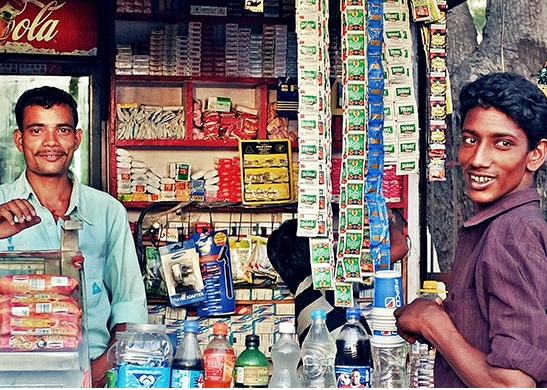Patanjali, the consumer goods brand promoted by outspoken yoga preacher Baba Ramdev, might have taken India by storm in recent times with plans to increase staff size fivefold within a year and open a chain of restaurants. But look around the stores, and at Nielsen’s survey, and the pole position occupied by local Indian brands seems to be giving way to the global majors: only a quarter of brands on India’s top 100 list are local firms.
At the same time, not a single Indian brand makes Asia’s top 100 list, according to Nielsen’s report. The first in the ranking is food cooperative Amul, at rank 126, but this is not Amul’s best performance. In 2015 it was ranked at 120, and it slipped to 127 last year.
The next Indian brand to make its presence felt is retailer Big Bazaar, in 240th position. From its peak spot at 205 in 2013, when the survey included India for the first time, Big Bazaar has been consistently sliding downwards.
India's largest bank, State Bank of India (SBI), also continues to sink: from Asia’s 536th top brand in 2013, it is now down to 886, its lowest position yet. A heap of bad loans and the Kingfisher Airlines controversy – the defunct carrier defaulted on loan repayments to Indian banks, of which SBI was one of the largest lenders - could have added to this poor performance. A recent initiative to merge six associates under one parent company, however, could shore up SBI’s ranking in the years to come.
These brands’ lack of standing outside their home country may simply be explained by that fact that India represents such a diverse, fast growing market for local brands that there is less of a need to ‘go global’ than there is for brands in smaller countries such as South Korea, which gave birth to global behemoths Samsung and LG.
Still, the Asia rankings do flag up the odd positive story around India’s local brands: the pharmacy company Apollo received its best result yet in 2017, coming in at 151st position to challenge rivals Watsons and Guardian/Mannings. This could be explained by Apollo’s recent physical expansion – it now counts over 2,500 shops in 18 Indian states and plans to add 250 more year on year – as well as clever new tools such as text alerts to remind customers to stock up on medicines. An app and other digital initiatives are also in the pipeline.
If one looks only at the Indian leg of the study, brand experts believe that the rise of nationalist sentiment, partly a result of prime minister Narendra Modi’s ‘Make in India’ movement, could be giving a fillip to the 'be local, buy local' initiative. Brand campaigns like Tata Salt and Bajaj V, which claims to be made out of warship Vikrant's metal, are all playing to these sentiments. Having said this, simply being local might not be an automatic guarantee of success: good value and trust is at the heart of many consumers’ relationships with brands.
India’s top 10 features just three local companies, the same trio that dominated in 2016: food major Amul leads the pack at number five, retailer Big Bazaar comes in at seven and Apollo drops one place to number 10, pushed down by the rise of adidas and Philips this year.
While consumer goods companies feature prominently – McCann’s ‘Truth About Global Brands’ study proves this is the category in which consumers trust local brands the most - other leading Indian brands are not far behind. Among them is telecoms major Airtel, which jumps two spots to number 42, and Air India, which slipped from 38th to 40th position. Kingfisher beer drops 17 places to 46; the lack of a close rival means this may be a response to the alcohol industry’s battles with recent rulings, such as the state of Bihar’s ban on drink and the increased tax on alcohol imposed last year.
Lakme, the Unilever owned Indian cosmetics brand, slips seven places to 37 and jewellery brand Tanishq plummeted 14 places to 48, a blow potentially caused by last year’s jewellers’ strike.
Startups, meanwhile, are faring surprisingly well with Indian consumers. After their categories were included in Nielsen’s list for the first time, cab firm Ola joined the ranking at a highly respectable 21st position, beating global rival Uber by one spot, while ecommerce company Flipkart came in at 35 and online travel booking site MakeMyTrip hit 38. These examples prove the point that as long as you are perceived as providing value, then the Indian consumer will welcome you with open arms.



